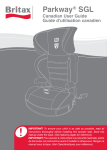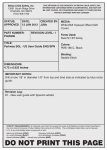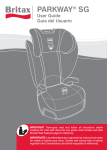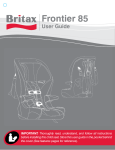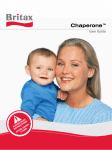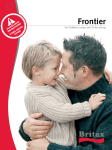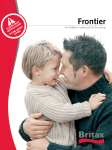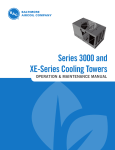Download Britax PARKWAY User guide
Transcript
Parkway® SGL User Guide PARKWAY SGL IMPORTANT: To ensure your child is as safe as possible, read all instructions thoroughly before installing this booster seat. Store this manual under the base. (See features pages for reference). Table of Contents Safety Information...................................................................... 2 Warnings...................................................................................... 2 Important Notes........................................................................... 4 Certification ................................................................................. 5 Registration.................................................................................. 5 Child Size: Height and Weight Limitations................................. 6 Vehicle Compatibility................................................................. 8 Vehicle Buckle Position............................................................... 9 Vehicle Seat Belts........................................................................ 10 Incompatible Vehicle Seat Belts................................................. 11 Child Seat Features.................................................................... 12 Using the Child Seat.................................................................. 14 Attaching the Backrest................................................................ 14 Removing the Backrest............................................................... 15 Adjusting the Backrest................................................................ 16 Adjusting Head Restraint Height................................................ 17 Using ISOFLEX™......................................................................... 18 SecureGuard™............................................................................ 20 Using the Retractable Cup Holders........................................... 21 Positioning the Booster Seat Positioning the Booster Seat and Securing Your Child with Backrest and ISOFLEX™.................................. 22 Positioning the Booster Seat and Securing Your Child without Backrest and with ISOFLEX™..................... 25 Positioning and Securing Your Child with Backrest and Lap-shoulder Belt Only................................ 28 Positioning and Securing Your Child without Backrest and Lap-shoulder Belt Only........................... 30 Care and Maintenance............................................................... 32 Warranty...................................................................................... 34 ©2010 Britax Child Safety, Inc. All rights reserved. Printed in USA P432700_R2:08.10 This product and its components are subject to change without notice. WARNING! DEATH or SERIOUS INJURY can occur: •Use only with children who weigh between 40 and 120 lbs (18.1 and 54.4 kg) and whose height is between 38 and 63 inches (96.5 and 160 cm). •Use only the vehicle’s lap and shoulder belt system when restraining the child in this booster seat. •Secure this child restraint with the vehicle child restraint anchorage system if available, or with a vehicle seat belt. •Follow all instructions on this child restraint and in the written instructions located under the base of the seat. •Register your child restraint with the manufacturer. •This booster seat is NOT for use with children who weigh less than 40 lbs (18.1 kg). •Use this booster seat forward-facing only. •DO NOT use this booster seat as a backless booster seat unless it is used in a seating position with a vehicle head restraint. •DO NOT use this booster seat as a backless booster seat unless proper vehicle belt placement can be achieved. •This booster seat must not be used in the home, in boats, or in other non-certified applications. •Secure this booster seat with a vehicle child restraint anchorage system or a vehicle seat belt even when it is not occupied. In a crash, an unsecured booster seat may injure other occupants. 2 •Based on crash statistics, the National Highway Traffic Safety Administration (NHTSA) recommends that parents select the rear seat as the safest location for a properly positioned booster seat. Please study the section on Vehicle Compatibility in this booklet to ensure the child’s safety. If in doubt about installing this booster seat, consult the vehicle owner’s manual. •DO NOT use any part of this booster seat with other seat cushions or backrests. •The use of non-Britax covers, inserts, toys, accessories or tightening devices is not approved by Britax. Their use could cause this booster seat not to perform as intended. •To prevent injury due to deterioration, discontinue use of a booster seat that is older than six years or has been in a severe crash. •The primary protection for occupants of a vehicle in a collision is the structure of the vehicle itself; a booster seat will not protect a child when the vehicle is seriously impacted. However, correctly installed, a booster seat will substantially improve the chances for survival in most crashes. Make sure that all users fully understand the correct ways to use this booster seat in a vehicle. 3 Safety Information Safety Information Important Notes Certification •The NHTSA and the American Academy of Pediatrics recommends that children should remain in a child seat with a 5-point harness until reaching the maximum weight or height allowed. •Cover the booster seat when the vehicle is parked in direct sunlight. Parts of the booster seat could become hot enough to burn a child. •Store the booster seat in a safe place when it is not being used. Avoid placing heavy objects on top of the booster seat. •DO NOT leave children alone in a vehicle, even for a short time. •DO NOT, except as described in this booklet, attempt to disassemble any part of the booster seat or change the way the vehicle’s seat belts are used. •DO NOT leave loose objects, e.g. books, bags, etc., in the back of a vehicle. In the event of a sudden stop, loose objects will keep moving, potentially causing serious injuries. •DO NOT leave folding vehicle seats unsecured. In the event of a sudden stop, a loose seat back could cause the booster seat not to perform as intended. •DO NOT allow children to play with this booster seat. •DO NOT use anything to raise the booster seat off the vehicle seat. In a crash, this could cause the booster seat not to perform as intended. This child restraint system conforms to all applicable Federal Motor Vehicle Safety Standards (FMVSS 213). This Child Restraint is Approved for Use in Motor Vehicles. This Restraint is Not Certified for Use in Aircraft, because Aircraft do not have shoulder belts. 4 Registration Child restraints could be recalled for safety reasons. You must register this restraint to be reached in a recall. Send your name, address, e-mail address if available, and the restraint’s model number and manufacturing date to Britax Child Safety, Inc. P.O. Box 91167 Allentown, PA 18109-9925, or call 1-888-427-4829, or register online at www.BritaxUSA. com/registration. For recall information, call the U.S. Government’s Vehicle Safety Hotline at 1-888-327-4236 (TTY 1-800-424-9153), or go to http://www.NHTSA.gov. For your convenience, record all the information about your booster seat below. Refer to the Serial Number and Manufacture Date Label for all information, see page 13. Model Name and Number:________________________________ Serial Number:__________________________________________ Batch Number:__________________________________________ Date of Manufacture:_____________________________________ 5 Safety Information Child Size: Height and Weight Limitations When Using with Backrest Only use forward-facing with children: •who weigh between 40 and 120 lbs (18.1 and 54.4 kg) and •who are between 38 and 63 in. (96.5 and 160 cm) in height and •when the top of the child’s ears are below the top of the head restraint (Fig. A) and •when the shoulder belt lies across the center of the child’s chest and is positioned at or above the child’s shoulder through the shoulder belt guide and a •when the lap belt is routed under the armrests, through the SecureGuard, across the child’s upper thighs. WARNING! DO NOT use the booster seat with the backrest if any of the following apply: •the child weighs less than 40 lbs (18.1 kg) or •the child weighs more than 120 lbs (54.4 kg) or •the child is less than 38 in. (96.5 cm) in height or •the child exceeds 63 in. (160 cm) in height b or •the top of the ears are above the top of the fully raised head restraint (Fig. B). 6 Safety Information When Using without Backrest Only use forward-facing with children: •who weigh between 40 and 120 lbs (18.1 and 54.4 kg) and •who are between 38 and 63 in. (96.5 and 160 cm) in height and •when the top of the child’s ears are below the top of the vehicle head restraint and •when the shoulder belt lies across the center of the child’s chest and is positioned at or above the child’s shoulder (Fig. C) and •when the lap belt is routed under the armrests, through c the SecureGuard, across the child’s upper thighs. WARNING! DO NOT use the booster seat without the backrest if any of the following apply: • the child weighs less than 40 lbs (18.1 kg) or • the child weighs more than 120 lbs (54.4 kg) or • the child is less than 38 in. (96.5 cm) in height or • the child exceeds 63 in. (160 cm) in height or • the top of the ears are above the top of the fully raised vehicle head restraint (Fig. D) or • proper vehicle seat belt positioning cannot be achieved across the child’s shoulder and upper thighs. d 7 Vehicle Compatibility WARNING! Based on crash statistics, the National Highway Traffic Safety Administration (NHTSA) recommends that parents select the back seat as the safest location for a properly positioned booster seat. DO NOT place a booster seat on the front seat with an air bag unless it is deactivated. DEATH or SERIOUS INJURY can occur. See your vehicle owner’s manual for booster seat positioning instructions. The back seat is the safest place for children 12 and under. This booster seat must only be used in forward-facing vehicle seats. Side-facing or rear-facing seats CANNOT be used. For questions about positioning the booster seat consult the vehicle owner’s manual. Some vehicles have no seating positions which are compatible with this booster seat or any other child seat. See diagram below. 8 Vehicle Compatibility Vehicle Buckle Position WARNING! The position of the vehicle seat belt buckle can adversely affect the stability of the booster seat. If the buckle lies near the incorrect position ( ) when the vehicle seat belt is tightened, try fitting the booster seat in another seating position OR consult your vehicle owner’s manual to see if you can lower the vehicle buckle position by twisting the vehicle buckle stalk. If it is not possible to achieve the correct position ( ) for the buckle, then another seating position or child seat MUST be used. 9 Vehicle Compatibility Vehicle Seat Belts Vehicle Compatibility IMPORTANT: Vehicle seats and vehicle seat belts differ from Incompatible Vehicle Seat Belts WARNING! The following types of vehicle seat belts are NOT compatible with this booster seat: To protect your child in a crash, you must use this booster seat with vehicle seat belts that are compatible. This booster seat can only be used with three-point (shoulder and lap) vehicle seat belts. The vehicle owner’s manual will have information on the types of vehicle seat belts in your vehicle. If your vehicle seat belt type is identified on page 11 as incompatible, select another seating position. 1 Vehicle seat belts with top or bottom anchor points on the vehicle door. vehicle to vehicle. Refer to your vehicle owner’s manual for specific information about vehicle seat belts and their use with child seats. This booster seat can fit securely in most vehicles using existing vehicle seat belts. However, some vehicles do not have seating positions which are compatible with this booster seat or any other child seat. If in doubt, contact the vehicle manufacturer for assistance. 2 Inflatable lapshoulder belts. 4 Lap-shoulder belts that have a separate retractor each for the lap and shoulder parts. 10 3 Motorized, automatic vehicle seat belts 5 Lap belts of any kind. 11 Child Seat Features Child Seat Features 1 2 PARKWAY 21 SGL PARKWAY SG L Parkway® SGL User Guide 3 13 IMPORTANT: To ensure your child is as safe as possible, read all instructions thoroughly before installing this child seat. Store this manual under the base. (See features pages for reference). 4 12 22 5 6 7 13 18 9 10 8 20 11 14 19 16 15 = 17 23 1 Head Restraint 10 ISOFLEX™ Adjuster Strap 18 Backrest Hinge Cylinder 2 Head Restraint Cover 11 Cup/Snack Holders 19 Base Hinge Slot 3 Backrest Cover 12 Head Restraint Height Adjuster 20 SecureGuard™ Adjuster 4 Backrest 13 Shoulder Belt Guides 21 User Guide Storage Slot 5 Armrests 14 Lower Connector Release Button 6 SecureGuard™ Clip 15 Lower Connectors 22 Serial Number and Manufactured Date Label 7 Base Belt Guide 16 Base 8 Base Cover 17 Elastic Retainers 23 ISOFLEX™ Flexible Lower LATCH Connection System 9 ISOFLEX™ Release Button 12 * Appearance of actual product may vary from images in this user guide. * Appearance of actual product may vary from images in this user guide. 13 Using the Child Seat Using the Child Seat Before you use this booster seat for the first time, you will have to complete the assembly steps below. Removing the Backrest Attaching the Backrest 2 Detach the seat cover from the base by unhooking the elastic loops from the elastic retainers on the back of the base (Fig. E). IMPORTANT: Keep fingers away from moving parts to avoid potential injury. 1 Detach the elastic loops from the elastic retainers on the base cover from the back of the booster seat base (Fig. A). 2 Place the base on a flat surface. From the child’s left side of the booster seat, align the backrest hinge cylinder with the hinge slot on the base. 3 Push the backrest hinge all the way into the base hinge slot (Fig. B). IMPORTANT: DO NOT rotate the backrest until the cylinder has been completely inserted into the base hinge slot. Rotating the backrest before it has been completely inserted may result in damage to the booster seat. a 1 Place the booster seat on a flat surface. 3 Push the backrest down until it lies flat and align the backrest hinge cylinder with the hinge slot on the base (Fig. F). e 4 Slide the backrest from the child’s left side of the base (Fig. G). b 5 Attach the elastic loops of the base cover to the elastic retainers on the back of the base (Fig. H). f NOTE: Store the backrest in a safe place. c g d h 4 Rotate the backrest up until it doesn’t rotate into the flat position under its own weight (Fig. C). 5 Attach the elastic loops of the base cover to the elastic retainers on the back of the booster seat (Fig. D). 14 15 Using the Child Seat Using the Child Seat Adjusting the Backrest WARNING! Reclining the vehicle seat back may adversely affect the position of the vehicle seat belt across the child and may result in death or serious injury in a crash. Refer to your vehicle owner’s manual for information on adjusting the vehicle seat back with child seats. Adjusting Head Restraint Height The head restraint can be adjusted and locked into different positions. Choose the position best suited to your child’s safety. See page 6. Tip: Check the fit with child seated in booster seat. Ensure that the shoulder belt guides are even with, or just above, the child’s shoulder. See page 6. 1 Squeeze and hold the height adjustment handle to adjust the head restraint (Fig. A). Push the backrest until it rests against the vehicle seat back (Fig. A). If the vehicle seat back is adjustable, move it to the upright position. 2 Slide head restraint up or down to the desired level (Fig. B). A 3 Release the adjustment handle. Repeat this process until the shoulder belt rests comfortably across the center of the child’s chest when positioned through the shoulder belt guide (Fig. C). A 4 Ensure the head restraint has locked into place. IMPORTANT: Do not recline the backrest past the allowable adjustable range (Fig. B). B B C 16 17 Using the Child Seat Using the Child Seat Using ISOFLEX™ Flexible Lower LATCH Connection System The ISOFLEX™ System helps to anchor the booster seat into the car for added stability and safety in the event of a crash. LOWER UNIVERSAL ANCHORAGE SYSTEM LOCATIONS Using the Lower Connectors Where to find the Lower Connectors The lower connectors are located in the back of the base of the booster seat. Store the connectors in the slots when not in use. To remove the lower connector from the storage slot or lower anchor: 1 Press and hold the red release button. 2 Pull the lower connector from the storage slot or lower anchor. Lower Lower Anchors The figure above shows typical locations for lower anchors in a vehicle. Check your vehicle owner’s manual to learn if it is equipped with lower anchors. Standard vehicle seat spacing between lower anchors is 11 inches (27.9 cm). This child seat can be used in a seating position with up to 20 inches (50.8 cm) of space between the lower anchors if the vehicle manufacturer allows. 18 To attach the lower connector to the storage slot or lower anchor: Top Firmly push the lower connector into the slot or lower anchor until a click is heard. 19 Using the Child Seat Using the Child Seat 2 Pull the SecureGuard™ adjuster away from the base. SecureGuard™ Britax recommends using SecureGuard to achieve the best vehicle seat belt placement. The SecureGuard™ clip should hold the lap part of the vehicle seat belt in place. The SecureGuard™ clip should be adjusted to keep the lap part of the vehicle seat belt positioned low across your child’s upper thighs (Fig. A). Ensure the bottom edge of the SecureGuard™ clip is level with your child’s upper thighs, however, the clip itself should not press into your child’s upper thighs. IMPORTANT: The lap part of the vehicle seat belt must not rest on the child’s abdomen. Adjusting SecureGuard™ Fit • To Shorten: 3 Feed the end of the SecureGuard™ webbing through the SecureGuard™ adjuster (Fig. D). a 4 Pull the webbing to remove slack from the SecureGuard™ adjuster. d 5 Move the SecureGuard™ clip to the center of the SecureGuard™ webbing. b The lower edge of the SecureGuard™ clip should be level with the child’s upper thighs once they have been secured in the booster seat. Using the Retractable Cup Holders 1 Locate the SecureGuard™ adjuster under the base. See page 13. 2 Pull the SecureGuard™ adjuster away from the base. c 3 Feed the webbing through the SecureGuard™ adjuster (Fig. B). 4 Pull the end of the SecureGuard™ adjuster webbing to tighten (Fig. C). • To Lengthen: 1 Locate the SecureGuard™ adjuster under the base. See page 13. 20 Pull the cup holder out from the booster base to use. Push the cup holder into the booster base to store. IMPORTANT: •DO NOT use with hot liquids. •DO NOT step on or put excess weight on the cup holder. 21 Positioning the Booster Seat Positioning the Booster Seat Positioning the Booster Seat and Securing Your Child with Backrest and ISOFLEX™ Before you begin: 99Check that your vehicle has lower anchors. 99If the vehicle seat back is adjustable, ensure it is in the upright position before placing the booster seat on the vehicle seat. 99Adjust the head restraint appropriately to fit child (see page 17). NOTE: If a click is not heard when connecting the lower connectors, the lower connector strap may be twisted or there may be debris in the lower connector. Correct either situation before continuing with the positioning process. positioned correctly on the vehicle seat (Fig. D). Guide the seat into place while pulling the ISOFLEX™ adjuster strap on either side of the booster seat to remove slack (Fig. E). 1 Remove lower connectors from the storage slots in the base (Fig. A). 2 Push the ISOFLEX™ adjuster release a 3 Place the booster on the vehicle seat. * Using the lower anchor farthest from you first will allow for easiest positioning. * You may need to turn the back of the booster seat towards you for easier access to the lower anchors. are not twisted and push the lower connectors onto their adjacent lower anchors (Fig. C). * A click confirms attachment. C 5 Ensure that the booster seat is NOTE: Before using the booster seat for the first time, you will need to complete the assembly instructions on page 14. button on one side of the booster seat and pull to fully extend the lower connector strap. Then repeat on the opposite side to ensure that all slack has been released from the ISOFLEX™ system (Fig. B). 4 Verify that the ISOFLEX™ straps NOTE: * If needed, adjust or remove the vehicle’s head restraint to allow the backrest to lie flat against the vehicle’s seat back. * Only tighten until the slack is removed from the strap. Overtightening the strap can force the backrest of the booster seat forward (Fig. F). D E B F 22 23 Positioning the Booster Seat Positioning the Booster Seat Positioning the Booster Seat and Securing Your Child without Backrest and with ISOFLEX™ 6 Sit your child in the booster seat and check the head restraint for proper height adjustment. 7 Pull the vehicle seat belt out and route the Before you begin: shoulder part of the vehicle seat belt through the upper belt guide (Fig. F). 8 Route the lap part of the vehicle seat belt under the armrest and over both red belt guides (Fig. G). F 99If the vehicle seat back is adjustable, ensure it is in the upright position before placing the booster seat on the vehicle seat. 9 Verify that the vehicle seat belt is not twisted and fasten across the child (Fig. H). 99Ensure the booster seat is positioned in a location that has a vehicle head restraint. 10Route the lap part of the vehicle seat belt through the SecureGuard™ clip (Fig. I). * The lap part of the vehicle seat belt should rest low on the child’s upper thighs. G 11Remove slack from the vehicle seat belt. 99Vehicle seat belt is not twisted 99Vehicle seat belt is securely fastened 99Shoulder part of the vehicle seat belt is routed through the shoulder belt guide 99Lap part of the vehicle belt is routed through the SecureGuard™ clip 99Vehicle seat belt is properly positioned low across the child’s upper thighs and does not contact the child’s neck 99If the lower connectors in your vehicle prevent proper vehicle belt fit across your child you cannot use the lower anchors to position this booster seat 24 1 Remove lower connectors from the storage slots in the base (Fig. A). 2 Push the ISOFLEX™ adjuster release * The shoulder part should cross the chest in the center of the child’s collar bone. Checklist 99Check that your vehicle has lower anchors. H button on one side of the booster seat and pull to fully extend the lower connector strap. Then repeat on the opposite side to ensure that all slack has been released from the ISOFLEX™ system (Fig. B). a 3 Place the booster seat on the vehicle I seat. * Using the lower anchor farthest from you first will allow for easiest positioning. * You may need to turn the back of the booster seat toward you for easier access to the lower anchors. B 4 Verify that the ISOFLEX™ straps are not twisted and push the lower connectors onto their adjacent lower anchors (Fig. C). * A click confirms attachment. C 25 Positioning the Booster Seat Positioning the Booster Seat NOTE: If a click is not heard when connecting the lower connectors, the lower connector strap may be twisted or there may be debris in the lower connector. Correct either situation before continuing with the positioning process. 5 Ensure that the booster seat is positioned correctly on the vehicle seat (Fig. D). Guide the seat into place while pulling the ISOFLEX™ adjuster strap on either side of the booster to remove slack (Fig. E). 10Route the lap part of the vehicle seat belt through the SecureGuard™ clip (Fig. G). * The lap part of the vehicle seat belt should rest low on the child’s upper thighs. G D 11Remove slack from the vehicle seat belt. * The shoulder part should cross the chest in the center of the child’s collar bone (Fig. H). NOTE: Only tighten until the slack is removed from the strap. H E 6 Sit your child in the booster seat. Checklist 7 Pull the vehicle seat belt out, positioning the lap belt under both armrests and over both red belt guides (Fig. F). 8 Verify that the vehicle seat belt is not twisted and then fasten. 9 Adjust the vehicle seat belt’s shoulder part so that it crosses the chest and center of the child’s collar bone. 26 F 99Vehicle seat belt is not twisted 99Vehicle seat belt is securely fastened 99Lap part of the vehicle belt is routed through the SecureGuard™ clip 99Vehicle seat belt is properly positioned low across the child’s upper thighs and does not contact the child’s neck 99If the lower connectors in your vehicle prevent proper vehicle belt fit across your child you cannot use the lower anchors to position this booster seat 27 Positioning the Booster Seat Positioning the Booster Seat Positioning and Securing Your Child with Backrest and Lap-shoulder Belt Only 4 Pull the vehicle seat belt out and route the shoulder part of the vehicle seat belt through the upper belt guide (Fig. C). 5 Route the lap part of the vehicle seat belt under Before you begin: 99If the vehicle seat back is adjustable, ensure it is in the upright position before placing the booster seat on the vehicle seat. 99Adjust the head restraint appropriately to fit child (see page 17). both armrests, over your child’s upper thighs and over both red belt guides (Fig. D). c 6 Verify that the vehicle seat belt is not twisted and then fasten the vehicle seat belt across the child (Fig. E). 7 Route the lap part of the vehicle seat belt through the SecureGuard™ clip (Fig. I). * The lap part of the vehicle seat belt should rest low on the child’s upper thighs. Note: Before using the booster seat for the first time, you will need to complete the assembly instructions on page 14. 8 Remove slack from the vehicle seat belt. 1 Place the booster seat on the vehicle seat. 2 Push the backrest until it rests against the vehicle seat back (Fig. A). If the vehicle seat back is adjustable, move it to the normal upright position. a head restraint for proper height adjustment (Fig. B). 28 * The shoulder part should cross the chest in the center of the child’s collar bone. e Note: If needed, adjust or remove the vehicle’s head restraint to allow the backrest to lie flat against the vehicle’s seat back. 3 Sit your child in the booster seat and check the d b Checklist 99Vehicle seat belt is not twisted 99Vehicle seat belt is securely fastened 99Shoulder part of the vehicle seat belt is routed through the shoulder belt guide 99Lap part of the vehicle belt is routed through the SecureGuard™ clip 99Vehicle seat belt is properly positioned low across the child’s upper thighs and does not contact the child’s neck f 29 Positioning the Booster Seat Positioning the Booster Seat Positioning and Securing Your Child without Backrest and Lap-shoulder Belt Only Before you begin: 99If the vehicle seat back is adjustable, ensure it is in the upright position before placing the booster seat on the vehicle seat. 99Ensure the booster seat is positioned in a location that has a vehicle head restraint. Note: Before using the booster seat without the backrest, you may need to complete the removal instructions on page 15. 6 Route the lap part of the vehicle seat belt through the SecureGuard™ clip (Fig. C). * The lap part of the vehicle seat belt should rest low on the child’s upper thighs. 7 Remove slack from the vehicle seat belt. * The shoulder part should cross the chest in the center of the child’s collar bone. c Checklist 99Vehicle seat belt is not twisted 99Vehicle seat belt is securely fastened 99Lap part of the vehicle belt is routed through the SecureGuard™ clip 99Vehicle seat belt is properly positioned low across the child’s upper thighs and does not contact the child’s neck 1 Place the booster seat base on the vehicle seat and push it back against the vehicle seat back. 2 Sit your child in the booster seat. 3 Pull the vehicle seat belt out from the retractor, positioning the lap belt under both armrests and over both red belt guides (Fig. A). a 4 Verify that the vehicle seat belt is not twisted and then fasten across the child. 5 Adjust the vehicle seat belt’s shoulder part so that it crosses the chest and center of the child’s collar bone (Fig. B). b 30 31 Care and Maintenance Care and Maintenance Cover Removal Cleaning the Cover Removing the Backrest Cover •HAND WASH, using cold water and mild soap. •LINE DRY, to prevent cover from shrinking. •DO NOT: Bleach, machine wash, or machine dry. 1 Detach the elastic loops (6 total) from the backrest (Fig. A). 2 Remove the backrest cover. NOTE: Be careful not to damage the EPS foam. a C Replacing the Cover To replace the cover, reverse the steps of each section. Removing the Head Restraint Cover Cleaning the Shell 1 Detach the elastic loops (6 total) from the backrest (Fig. B). 2 Remove the head restraint cover. Removing the Seat Cover 1 Detach the elastic loops (4 total) from the booster seat base (Fig. C). 2 Slide the plastic retainer flaps (3 total) from the front and sides of the booster seat base (Fig. D). b D •SPONGE CLEAN, using warm water and mild soap. •TOWEL DRY •DO NOT: Use solvents, abrasive cleaners, or disassemble the booster seat in any way, except as instructed. 3 Remove the booster seat cover. 32 33 Warranty This booster seat was manufactured by Britax. Britax Child Safety, Inc. (“Britax”) warrants this product to the original retail purchaser as follows: LIMITED WARRANTY This booster seat is warranted against defective materials or workmanship for one year from the date of original purchase. Proof of purchase is required. The exclusive remedy for this warranty is that Britax will, at its option, provide repair or replacement components for this product. Britax reserves the right to discontinue or change fabrics, parts, models or products, or to make substitutions. To make a claim under this warranty, contact Britax Consumer Services at 1-888-427-4829 or write to us using the address on the back cover of this booklet. Proof of purchase is required. PLEASE COMPLETE AND MAIL THE OWNER REGISTRATION CARD WITHIN (30) DAYS OF PURCHASE OR VISIT WWW.BRITAXUSA.COM/REGISTRATION. WARRANTY LIMITATIONS This warranty does not include damages that arise from negligence, misuse or use not in accordance with the product instruction. The use of non-Britax Child Safety, Inc. covers, inserts, toys, accessories, or tightening devices is not approved by Britax. Their use could cause this child seat to fail Federal Safety Standards or not perform as intended in a crash. Their use automatically voids the Britax warranty. LIMITATION OF DAMAGES The warranty and remedies as set forth above are exclusive and in lieu of all others, oral or written, express or implied. In no event will Britax, or the retailer selling this product, be liable for any damages, including incidental or consequential damages, or loss of use arising out of the use or inability to use this product. LIMITATIONS OF WARRANTIES AND OTHER WARRANTY TERMS AND STATE LAWS Any implied warranties, including implied warranties of merchantability and fitness for a particular purpose, shall be limited to the duration and terms of the express written warranty. Some states do not allow limitations on how long an implied warranty lasts or the exclusion or limitation of incidental or consequential damages, so the above limitations may not apply. This warranty gives you specific legal rights, and you may have other rights, which vary from state to state. Neither Britax, nor the retailer selling this product, authorizes any person to create for it any other warranty, obligation, or liability in connection with this product. 34 35 36 Britax Child Safety, Inc. 13501 South Ridge Drive Charlotte, NC 28273 USA A Britax Childcare Group Limited company Tel. : 1-888-427-4829 www.Britax.com





















